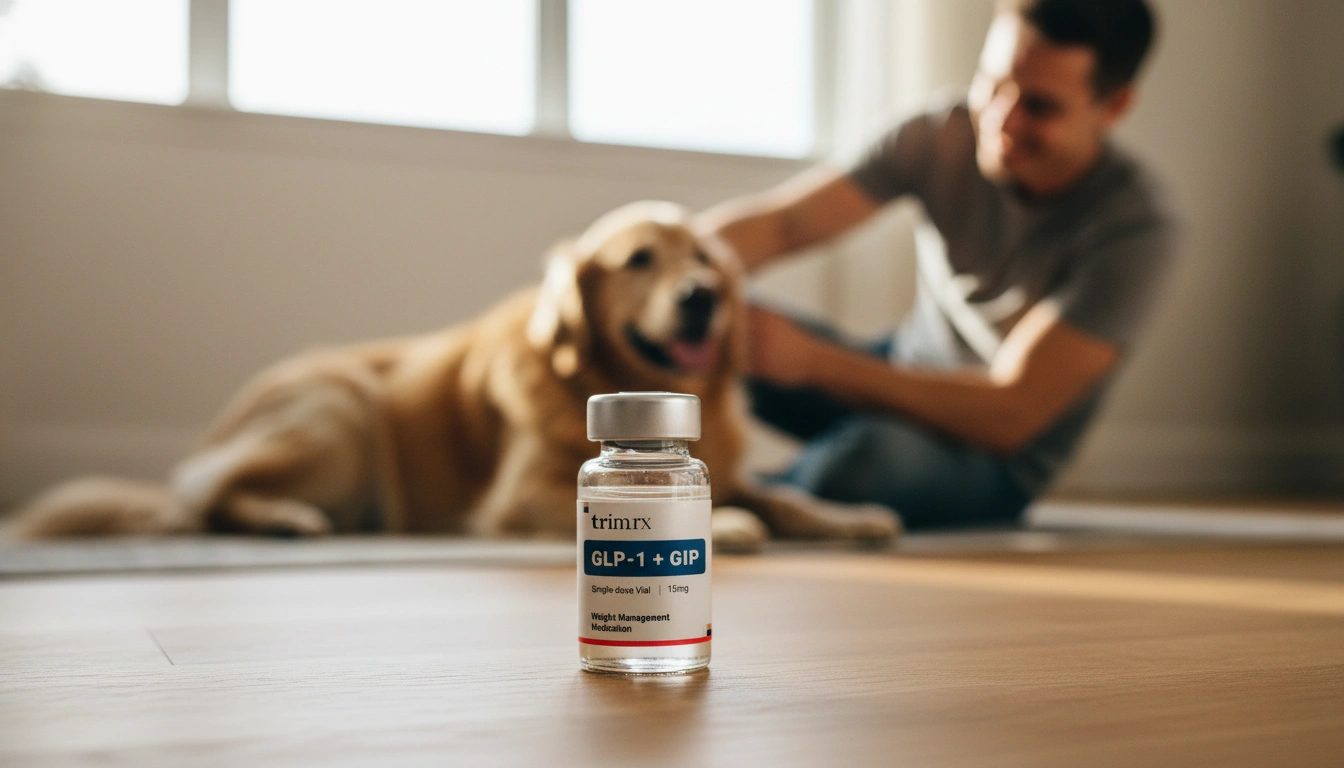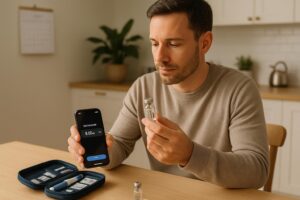How is GLP-1 Administered? A Comprehensive Guide to Understanding GLP-1 Medications

Introduction
GLP-1, or glucagon-like peptide-1, is a hormone produced in the intestines that plays a crucial role in regulating appetite and blood sugar levels. Medications that mimic this hormone, known as GLP-1 receptor agonists, have gained popularity for their effectiveness in treating type 2 diabetes and aiding weight loss. With FDA-approved options like semaglutide (Ozempic® and Wegovy®), liraglutide (Victoza®), and tirzepatide (Mounjaro®), individuals can access powerful tools to support their health goals.
The administration of GLP-1 medications is a vital aspect that directly impacts their effectiveness and the patient experience. This post will delve into how GLP-1s are administered, the different formulations available, and the best practices for ensuring safe and effective use.
As we navigate through this topic, we will also emphasize the importance of a supportive environment, such as the one we foster at TrimRx, where personalized care and advanced medical science guide our clients toward sustainable weight loss and healthier living.
The landscape of weight management and diabetes treatment has evolved significantly in recent years, with new medications emerging to empower individuals on their health journeys. One such breakthrough is the class of medications known as GLP-1 receptor agonists. Have you ever wondered how these medications are administered and how they work? Understanding the administration of GLP-1 medications is essential for anyone considering their use or supporting someone who is.
In this blog post, we will explore the ins and outs of GLP-1 medications, including their mechanisms of action, administration methods, and important considerations for those using them. We aim to provide an in-depth, informative resource to guide you through the complexities of GLP-1 administration and how it fits into a comprehensive weight loss or diabetes management plan. By the end of this article, you’ll have a clearer picture of how GLP-1 medications can be integrated into a healthy lifestyle, emphasizing our commitment at TrimRx to personalized, medically supervised weight loss solutions that reflect our values of empathy, science, and transparency.
What Are GLP-1 Receptor Agonists?
Before discussing how GLP-1 medications are administered, it’s essential to understand what they are and how they function. GLP-1 receptor agonists are synthetic versions of the natural GLP-1 hormone. They mimic the hormone’s effects by binding to GLP-1 receptors in the body, which leads to several physiological responses:
- Increased Insulin Secretion: GLP-1 stimulates the pancreas to release insulin when blood sugar levels are high, helping to lower blood glucose levels after meals.
- Decreased Glucagon Secretion: Glucagon is another hormone produced by the pancreas that raises blood sugar levels. GLP-1 reduces glucagon secretion, further aiding in blood glucose control.
- Slowed Gastric Emptying: By slowing the rate at which food leaves the stomach, GLP-1 receptor agonists help prolong feelings of fullness, which can lead to reduced overall food intake.
- Appetite Suppression: GLP-1 influences brain regions responsible for hunger and satiety, helping to curb appetite and reduce cravings.
The benefits of GLP-1 medications extend beyond blood sugar management, as they have also been shown to promote significant weight loss in individuals with obesity or overweight. At TrimRx, we take pride in offering personalized weight loss programs that include GLP-1 medications, working with FDA-registered pharmacies to ensure safe and effective treatment options tailored to individual needs.
How Are GLP-1 Medications Administered?
GLP-1 receptor agonists are primarily administered through injections. Understanding the administration process is key for individuals who may be new to these treatments.
1. Injection Sites
GLP-1 medications are injected subcutaneously, which means they are administered into the fatty tissue just beneath the skin. Common injection sites include:
- Abdomen: This is often the preferred site due to its accessibility and ease of use.
- Outer Thigh: Another common area that allows for easy self-administration.
- Upper Buttocks: This site can also be used, especially if other areas are inconvenient.
- Back of the Arm: This area may be suitable for some individuals, though it may be less accessible for self-injection.
2. Types of GLP-1 Medications
There are various GLP-1 medications available, each with specific administration guidelines:
- Once-Weekly Injections: Medications like semaglutide (Ozempic®) and tirzepatide (Mounjaro®) are designed for once-weekly administration, making them convenient for individuals who prefer fewer injections.
- Daily Injections: Some formulations, such as liraglutide (Victoza®), require daily injections. These may be more suitable for individuals who need more immediate blood sugar control.
- Oral Formulations: While traditional GLP-1 medications are injectables, semaglutide is also available in an oral form (Rybelsus®), which provides a non-injection option for those who prefer it.
3. Injection Technique
Proper injection technique is crucial for the effectiveness of GLP-1 medications. Here are some best practices:
- Clean the Injection Site: Use an alcohol swab to clean the area before injecting to reduce the risk of infection.
- Pinch the Skin: Gently pinch the skin to create a fold, which can help ensure the medication is injected into the fatty tissue.
- Insert the Needle: Insert the needle at the appropriate angle (usually 90 degrees for subcutaneous injections) and push the plunger to deliver the medication.
- Withdraw and Dispose: After injecting, withdraw the needle and dispose of it properly in a sharps container.
- Rotate Injection Sites: To prevent irritation and lipodystrophy (changes in the fat layer under the skin), it’s essential to rotate injection sites with each dose.
At TrimRx, we understand that learning to administer injections can be daunting for some individuals. Therefore, our healthcare providers offer guidance and support to ensure you feel comfortable and confident in your injection technique.
4. Frequency of Administration
The frequency of GLP-1 administration depends on the specific medication prescribed. As mentioned earlier, some are administered weekly, while others require daily doses. It’s important to adhere to the prescribed schedule to achieve the best results. Missing doses can lead to fluctuations in blood sugar levels and may hinder weight loss efforts.
5. Monitoring and Follow-Up
Once you begin a GLP-1 regimen, regular follow-up appointments with your healthcare provider are essential. These appointments allow for monitoring your progress, adjusting dosages if necessary, and addressing any potential side effects or concerns. At TrimRx, we prioritize ongoing support, providing our clients with resources and assistance throughout their weight loss journeys.
The Benefits of GLP-1 Medications
GLP-1 medications offer numerous benefits beyond just managing blood sugar levels. Here, we explore some of the compelling reasons for considering GLP-1 therapy:
1. Weight Loss
One of the most significant advantages of GLP-1 receptor agonists is their ability to promote weight loss. Clinical studies have shown that individuals using medications like semaglutide and liraglutide can achieve substantial weight loss, often exceeding 10% of their body weight. This weight loss can have a positive impact on overall health, reducing the risk of obesity-related conditions such as heart disease, diabetes complications, and sleep apnea.
2. Improved Blood Sugar Control
GLP-1 medications are particularly effective at lowering blood sugar levels in individuals with type 2 diabetes. By enhancing insulin secretion and reducing glucagon levels, these medications help regulate blood glucose levels, leading to improved glycemic control. This is crucial for preventing complications associated with diabetes, such as neuropathy, kidney disease, and cardiovascular issues.
3. Cardiovascular Benefits
Emerging research suggests that GLP-1 medications may provide cardiovascular benefits, reducing the risk of heart disease and stroke. This is especially relevant for individuals with type 2 diabetes, who face a higher risk of cardiovascular complications. By promoting weight loss and improving metabolic health, GLP-1s may contribute to better heart health outcomes.
4. Enhanced Quality of Life
For many individuals, the ability to manage weight and blood sugar levels effectively can lead to an improved quality of life. Patients often report increased energy levels, enhanced mood, and greater overall satisfaction when using GLP-1 medications as part of their treatment plan.
5. Support for Lifestyle Changes
GLP-1 medications are often prescribed in conjunction with lifestyle changes, such as diet and exercise. By reducing appetite and promoting satiety, these medications can make it easier for individuals to adhere to healthier eating patterns and engage in physical activity. At TrimRx, we emphasize the importance of a holistic approach to weight loss, combining medical support with behavioral modifications.
Potential Side Effects and Considerations
While GLP-1 medications offer many benefits, it’s important to be aware of potential side effects and considerations:
1. Gastrointestinal Side Effects
Gastrointestinal symptoms such as nausea, vomiting, and diarrhea are common, especially when first starting GLP-1 therapy or increasing the dose. These side effects often improve over time as the body adjusts to the medication. At TrimRx, we encourage open communication about any side effects experienced, as adjustments may be necessary for optimal comfort and effectiveness.
2. Injection Site Reactions
Some individuals may experience mild reactions at the injection site, such as redness, itching, or swelling. Rotating injection sites can help minimize these reactions.
3. Risk of Hypoglycemia
While GLP-1 medications are generally associated with a lower risk of hypoglycemia compared to other diabetes treatments, they can still lead to low blood sugar, particularly when combined with other medications that lower glucose levels. It’s crucial to monitor blood sugar levels regularly and discuss any concerns with your healthcare provider.
4. Contraindications
GLP-1 medications may not be suitable for everyone. Individuals with a history of pancreatitis, certain gastrointestinal disorders, or specific types of thyroid cancer should avoid these medications. A thorough medical evaluation is essential to determine if GLP-1 therapy is appropriate.
Conclusion
GLP-1 receptor agonists represent a promising advancement in the treatment of type 2 diabetes and obesity. Understanding how these medications are administered, their benefits, and potential side effects is crucial for individuals considering this therapy. At TrimRx, we are dedicated to providing personalized, medically supervised weight loss solutions that empower individuals to achieve their health goals.
If you’re exploring whether GLP-1 medications are right for you, we encourage you to take our free assessment quiz to determine your eligibility for our personalized weight loss programs. Our commitment to empathy, science, and transparency ensures that you receive tailored support throughout your journey.
FAQ
What are GLP-1 medications used for?
GLP-1 medications are primarily used to treat type 2 diabetes and aid in weight loss for individuals with obesity or overweight.
How often do I need to take GLP-1 medications?
The frequency of administration varies depending on the specific medication. Some are given weekly, while others require daily injections.
Can I take GLP-1 medications if I have other health conditions?
It’s essential to discuss your medical history with your healthcare provider, as GLP-1 medications may not be suitable for individuals with certain conditions.
What should I do if I experience side effects?
If you experience side effects, contact your healthcare provider to discuss your symptoms and explore potential adjustments to your treatment plan.
How can TrimRx support my weight loss journey?
At TrimRx, we offer personalized weight loss programs that include GLP-1 medications, unlimited support, and a comprehensive approach to health and wellness. Take our free assessment quiz to get started today!

Transforming Lives, One Step at a Time
Keep reading
7 Tips for Sticking to GLP-1 Injection Schedules
Seven practical strategies to keep weekly GLP‑1 injections on schedule—pick a routine day, set reminders, manage side effects, rotate sites, and avoid missed doses.
Custom GLP-1 Dosing for Kidney Disease
Personalized GLP-1 dosing for CKD patients with monitoring, dehydration and hypoglycemia risk mitigation, and guidance across all kidney disease stages.
Semaglutide vs Tirzepatide: Approved Uses
Two leading diabetes and weight-loss drugs differ in FDA-approved benefits — one adds heart, kidney and liver protection; the other treats obstructive sleep apnea.



